Zacuto Recoil Pro Shoulder Rig with Trigger Grips Review
For over a decade, Zacuto has been an industry leader in high quality, workhorse rigs for modern day cameras. But the new Zacuto Recoil Pro with Dual Trigger Grips kit might very well achieve the impossible: that is, to convince non shoulder rig shooters to become shoulder rig shooters.
With each new release, Zacuto has been tinkering and improving every little component that goes into one of their modular systems. Their flagship Recoil shoulder rig itself has gone through several iterations.
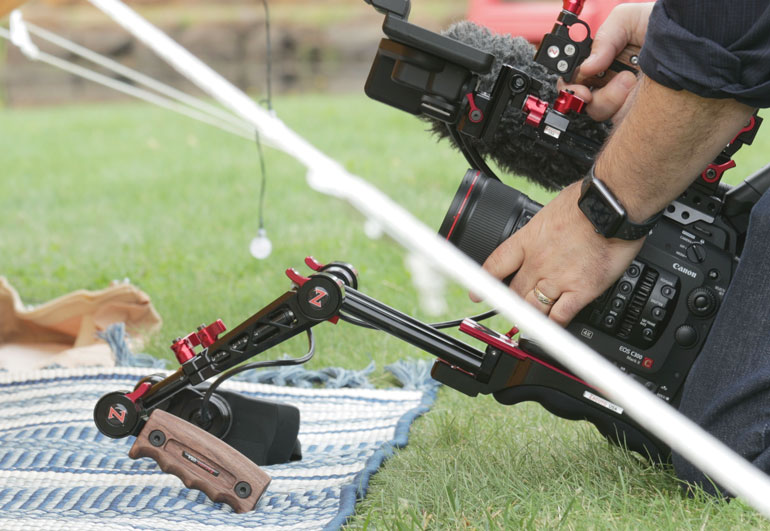
Today, the Next Gen Recoil Pro has a ton of features that are customized specifically for cameras like the Canon Cinema cameras, Sony FS7 and FS5, the Panasonic EVA1 and Varicam LT, Blackmagic Ursa, and most standard DSLR cameras and mirrorless cameras.
But it’s the most recent addition of trigger grips that elevate the Zacuto Recoil shoulder rig to the next level. With the press of a trigger button, you can quickly turn the above rig into a compact, folded form factor ready for low-angle, tripod, or monopod shooting, or packed away for travel.
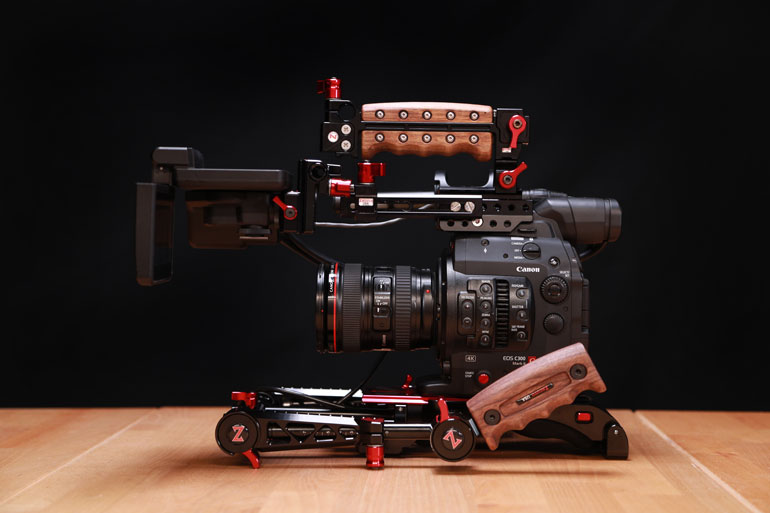
TL;DR - The Zacuto Recoil Pro with Trigger Grips is the newest and most advanced shoulder rig from Zacuto. The ability to quickly adjust and fold up the arms for compact shooting or travel makes this shoulder rig very attractive even for filmmakers who prefer shooting barebones or entirely on a tripod, monopod, or handheld.
Zacuto Recoil Pro Shoulder Rig and Trigger Grip Overview
Zacuto sells an assortment of parts and knick knacks that can be assembled into a custom rig, but for anyone who doesn’t already have a bunch of parts lying around, a kit can simplify what you need, and can also cost less than the sum of all the individual parts.
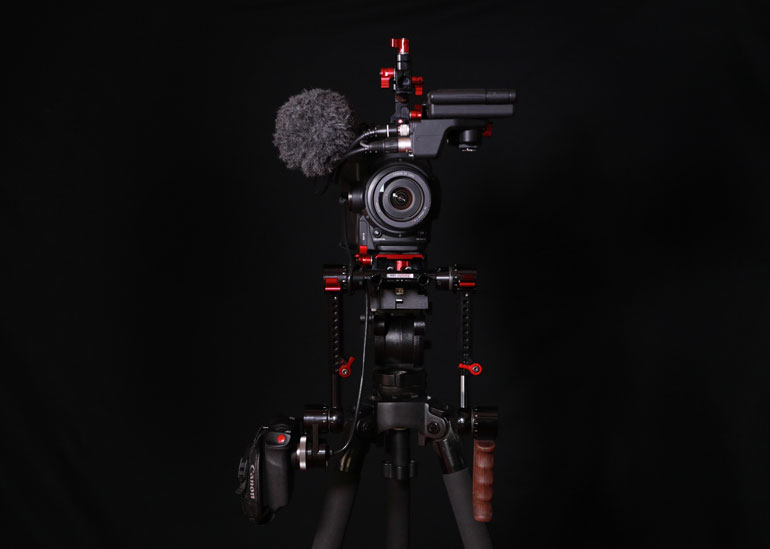
The Next Generation Recoil Rig includes three components: the VCT Pro baseplate on a shoulder pad, the camera top plate and handle, and a custom grip handle to extend the camera’s grip control.
There are various options for single or dual grips, and you choose the rig based on the camera you’re using: a Canon C100, C200, or C300/C500, a Panasonic EVA1, a Sony FS5 or FS7, or a universal kit for DSLR or mirrorless cameras.
The reason they are sorted by camera (and even the versions of the camera) is because Sony, Panasonic, and Canon each have different handgrip styles, mounts and connections. These aren't just physical designs - they have electrical components inside them that are custom engineered.
We've taken apart a Zacuto Canon grip relocator before - it's a sophisticated component. The fact that Zacuto has one for all the major camera manufacturers is a testament to their ability to quickly respond to new cameras with custom rigging solutions.

For cameras that don't have a grip handle, Zacuto has a universal - or “Indie” version - of the Recoil Pro kit, which comes with standard wooden handles. It works with any DSLR or mirrorless camera.
In each of these kits, you also have the option of adding a Zacuto EVF - like the Gratical Eye - or their infamous magnifying Z-finder loupe. If you want to use your camera’s default display, rather than an EVF or loupe, you might need an additional accessory that pushes the screen far enough away from your eyes that you don’t get cross eyed. More on that in a bit.
New Zacuto Trigger Grips
Zacuto's new Trigger Grip, in our opinion, is what elevates any of these Recoil Pro kits to a whole new level. In a nutshell, with just the press of the trigger button, you can rotate the grip handle, and another trigger button to adjust the whole arm, a full 360 degrees of rotation.
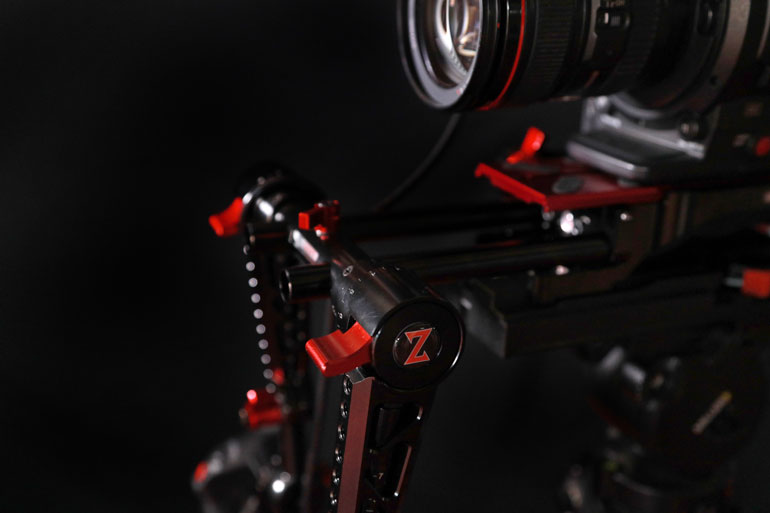
Additionally, you can extend or shorten the length of the handgrip with a simple lever halfway down the arm. Together with the trigger grip, you can adjust and perfect the exact length and angle of the arm and hand grip that feels right for you at that moment in time.
When you want to come down for a low angle shot, you can quickly rotate the arm (or both arms if you have the dual trigger grips), folding them next to the camera. This enables you to shoot with the camera as if you were shooting handheld, without the shoulder rig components preventing you from getting the camera in the position you want.

You can certainly buy a single trigger grip with a built in grip relocator for your camera of choice, and then connect it via rosette to the side of your current rig. But the dual trigger grip system has not only an additional left hand wooden grip (with trigger), but also a built-in connecting base that slides onto the 15mm rods on the Recoil Pro.

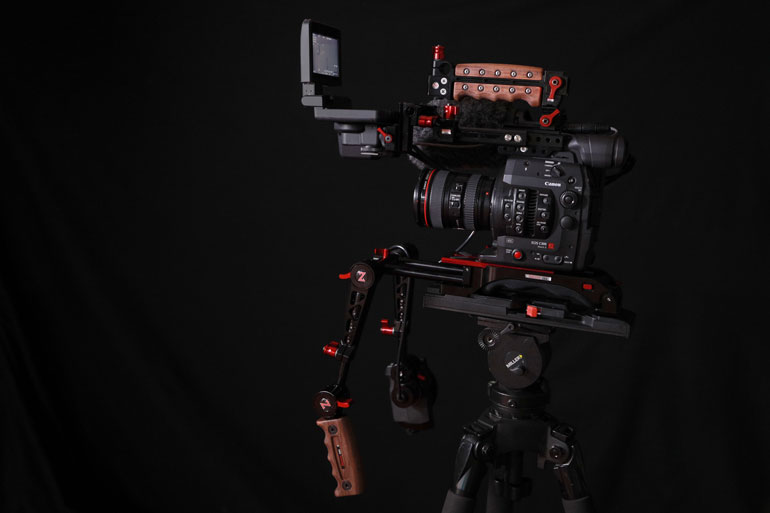
If you don’t have any of these pieces, we would recommend going for the full Recoil Pro with Dual Trigger Grips kit. For our review, we went with this Canon C300 mkII kit. It comes with a custom grip relocator as part of the kit - so you don’t need to buy an additional grip relocator.
But if you already have a 15mm rod-based shoulder rig, you can still add a dual trigger grip piece to your setup, and get all the benefits of these new innovative components with the shoulder rig setup you’re already comfortable with. There are custom camera options for Sony, Canon, and Panasonic, as well as “Shorty Trigger Grips” that can be added to any kit without a grip relocator.
If you use multiple cameras, you can always get a Dual Trigger Grip base, and then choose your hand grips later. The versatility of this system might seem a little overwhelming at first, but the point is, you’re never stuck in one particular kit for one specific camera and lens combination.
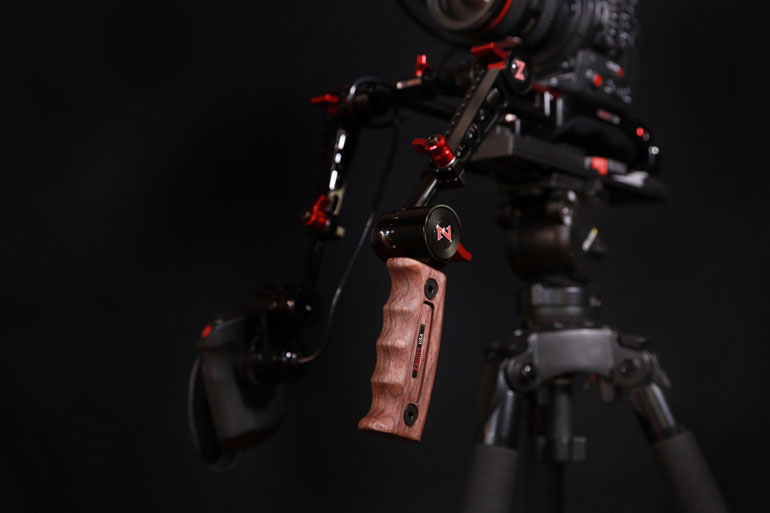
Zacuto also has developed a Dual Rosette Trigger Grip that connects to the Canon C200, Blackmagic Ursa, Panasonic Varicam LT, or any other Rosette based camera or lens grip that uses the Rosette connector.
If you shoot with the Canon C300 mkII and the 18-80mm compact servo lens, you could rig the C300 grip to your right handle, and the lens servo controls to your left, via the rosette. Now that would be a heavenly combination that someday we hope to test out.
Recoil pro shoulder rig and trigger grip review
For our review, we paired the Zacuto Recoil Pro and Dual Trigger Grip kit with our Canon C300 mkII. And to give it a true test, we went out on a real shoot with our friend Jem Schofield of theC47, who wanted to get his hands on the rig as well.
Here’s Jem's video review:
If you don't already, we recommend you subscribe to theC47 Youtube channel. Jem is committed to a weekly video, even with his busy schedule of nationwide filmmaking trainings and productions.
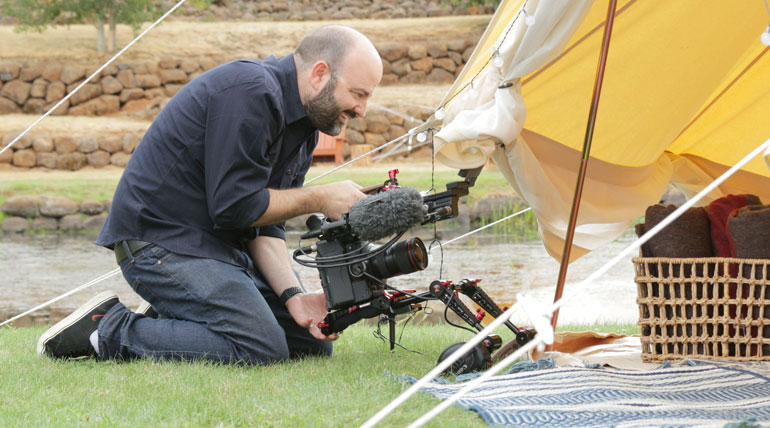
Jem and the Zacuto rig during our collaborative shoot
Canon Cinema Cameras: Handheld vs. Rigged Out
Canon’s cinema cameras, including the C300 mkII, have a very unusual shape compared to other cameras. They’re tall and uniquely shaped, as opposed to the long, boxy shape that make up most cinema cameras.
Because of the way it’s designed, the Canon C300 has become an immensely popular camera for handheld shooters. Documentary filmmakers can bring it into difficult environments without standing out among the crowd.
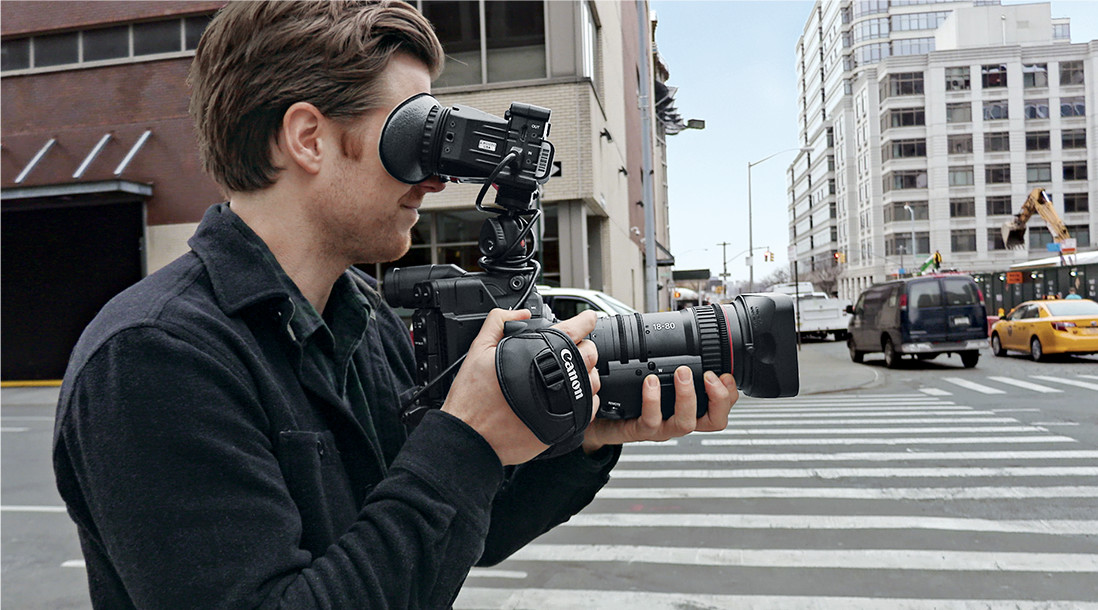
Cinematographer Nathan Golon using a C300 & 18-80mm. Credit: Canon Testimonials
You could do that with any small camera of course, or even a camcorder, but the C300 has a ton more going for it, including pro audio inputs, built in ND, interchangeable lenses, and that beautiful Canon look. It’s even more brilliant on the C300 mkII.
We don’t need to go on and on about the C300. Essentially, it’s a really nice camera for shooting handheld, without any further modification. That’s the way it was used for a lot of the crazy shots in "Cartel Land," as well as many other documentary features. And we know first hand that reality TV shooters continue to use the original C300 handheld on many productions.
Here's a video from Canon about Director/Cinematographer Matthew Heineman on shooting in dangerous, unpredictable locations with just his C300 and a Canon 17-55mm lens.
On the other side of the equation, you have professional filmmakers who like to build up their camera with an external monitor/recorder and/or an EVF, a follow focus, rails for a cine lens, grip handles, possibly a matte box, a wireless transmitter, a wireless audio receiver, and a big V-mount or Anton Bauer battery to power it all.
It might seem counter-intuitive, but it’s the latter, rigged-out style of shooter who has sought out the Zacuto shoulder rig to hold everything in place. Which is interesting, because for a handheld shooter, simply adding a little shoulder stabilization would help battle fatigue and shaky footage quite a bit.
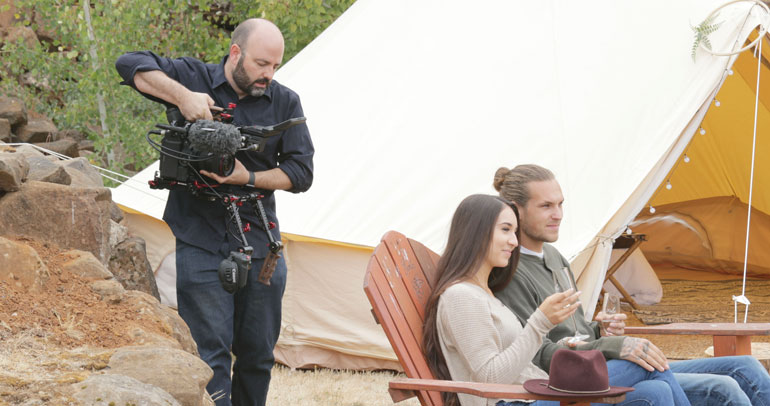
Adding Zacuto's shoulder rig without losing the ability to go handheld
But until Zacuto’s trigger grips, there hasn’t really been a “simple” shoulder rig for a shooter who prefers to keep his or her camera in its most basic form. You either move up to a full shoulder rig with an EVF, battery as a counterweight, handles, rails, follow focus - the whole nine yards - or you just avoid shoulder shooting altogether.
Interestingly enough, Matthew Heineman's partner on "Cartel Land," Matt Porwoll, prefers the rigged out form factor on a shoulder rig. Here's him talking about building out the C300 Mark II on various shoulder rig setups.
By the way, this documentary and BTS series was also directed by Jem Schofield. Is there anything he doesn't do?
Using a Shoulder Rig vs. Shooting with a Tripod, Monopod, and Handheld
For us, we’ve mostly avoided shoulder shooting because of this conundrum. Which is a shame, because there are many shoots where it makes so much more sense to shoot from a shoulder, rather than insist on a tripod, monopod, or go completely handheld.
We’ve kept our eye out on shoulder rigs from lots of manufacturers: Zacuto's Canon rigs, Wooden Camera's Unified C300 kit, Shape's shoulder rig, Tilta's universal shoulder rig kit, Movcam's C300 mkII kit, Vocas's handheld kit for C300, and even DIY kits people put together from various parts.
Nothing has really stood out as a shoulder rig for shooters who don’t want to completely transform their style of shooting.
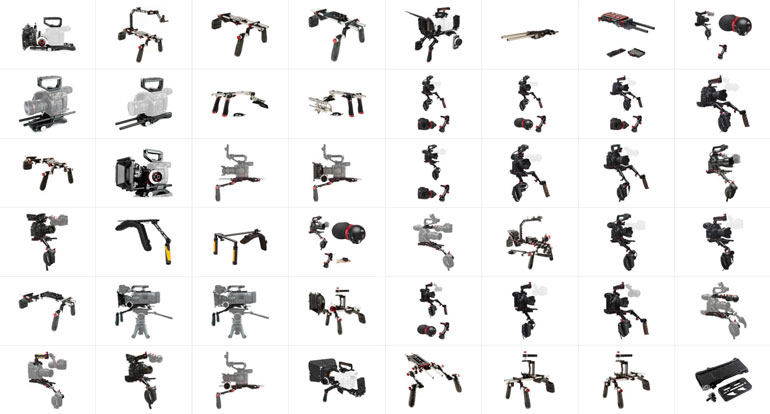
What happens when you search for "Canon shoulder rig" at B&H
So we’ve continued on without shoulder rigs. No matter what camera we’re using, we place a small quick release on the bottom (our favorite is the Manfrotto 394), and then move between shooting on a tripod, or on a video monopod like the Manfrotto Xpro, or on a slider, and even on a gimbal. That’s one benefit of keeping a camera simple and barebones.
But when a shoot requires more nimble movement, that’s when this system falls apart. We can go handheld, but it’s really hard to shoot stable handheld shots while you’re walking even slowly. And unfortunately, the super shaky cam look doesn’t match up with locked down, slider, and steadicam shots from the rest of the day.
We can move to a gimbal, but that’s a ton of setup for what gives you only for a wide shot. You can’t really shoot an entire scene with a wide, medium, and tight frame when you’re on a gimbal.
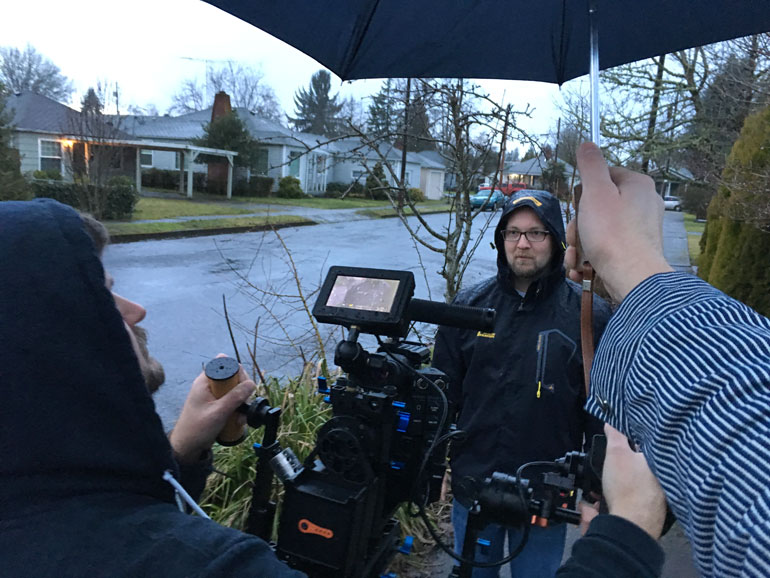
Using an A Cam like the C300 mkII on a gimbal is way more complicated than shooting handheld or on a shoulder
A monopod is often the best tool for the job, but in some cases, it’s also the worst one. For example, a monopod is very limited when you’re trying to shoot a simple two person conversation.
You want over the shoulder shots, with one subject’s blurry head in the foreground and the other subject framed looking at them. It seems simple enough, but it’s actually really frustrating with a monopod.

Every time one of your subject shifts a little, you have to pick up your monopod, move it a few inches, set it down, and try again. Each time you adjust your frame, you miss another shot. A conversation can go by very quickly and all you have is a two-shot master and a bunch of 1-second OTS shots that keep getting interrupted by shifting heads and monopod adjustments.
It shouldn’t be that difficult, but in an OTS two-shot, there is not much leeway in the frame. Both subjects need to be in the right place for it to work.
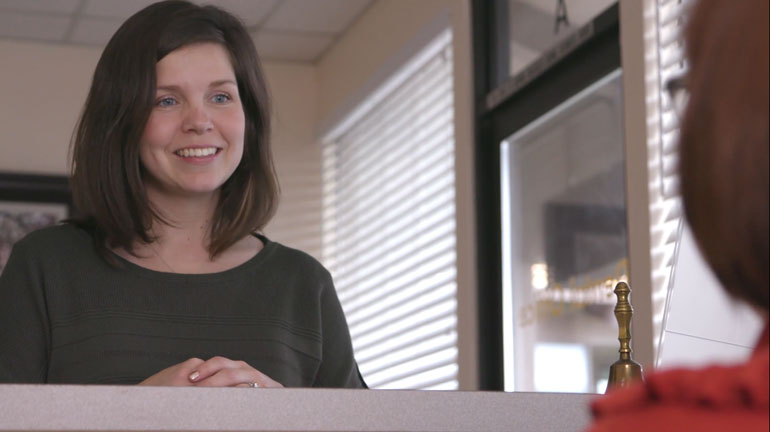
Of course with a shoulder rig, this is the simplest shot in the world, and in fact one of the best reasons to shoot from a shoulder in the first place. You can very easily shift your own body to adjust the frame, grabbing shots of both opposing subjects, plus cutaways like their hands and other details, in a very organic, almost ninja-like way.
In fact, you can do this even with subjects who are walking and talking. Imagine trying to get a stable walking conversation with multiple focal lengths in handheld mode, or on a gimbal, or a monopod (hint: you can’t).
And so, there are huge limitations even with a very basic camera setup. You think keeping the camera naked will help you be more nimble on a shoot, but in fact, it actually prohibits you from gathering stable footage during any position where you’re not standing still, holding the camera against your chest.
That’s especially true if you ever need to place a long, telephoto lens on your camera. Doing so while shooting handheld is an exercise in steady breathing while generating buckets of sweat.

Whereas in our day of shooting with the Zacuto Recoil Pro and Trigger Grips, we actually had a Canon 70-200mm f/4 lens on the C300 mkII for the majority of the shoot. Seeing that combination of a shoulder rig and long lens in action - for a majority of a shoot - was enough to convince us we needed to embrace the shoulder rig.
But what about the complexity of the kit? Don’t you still need to rig the camera with an EVF or loupe to make it work?
Using the C300 mkII on a Zacuto Recoil without an EVF
This is still one of the major barriers to moving from a basic camera setup to a shoulder rig. In order for the camera to sit comfortably on your shoulder, you need to have it placed back enough that it’s balanced right over the shoulder. For most cameras with a built-in display, that means you’ll need an external monitor or an EVF.
The thing is, if you haven’t already been shooting with an EVF for years as an ENG or camcorder operator, it’s kind of hard to make the transition. Those of us who came into filmmaking during the DSLR era don’t have that natural inclination to shoot with one eye buried in an EVF, feeling our way through camera controls as it sits back on our shoulder. We’re accustomed to looking at a camera and its built-in display and controls right in front of us.
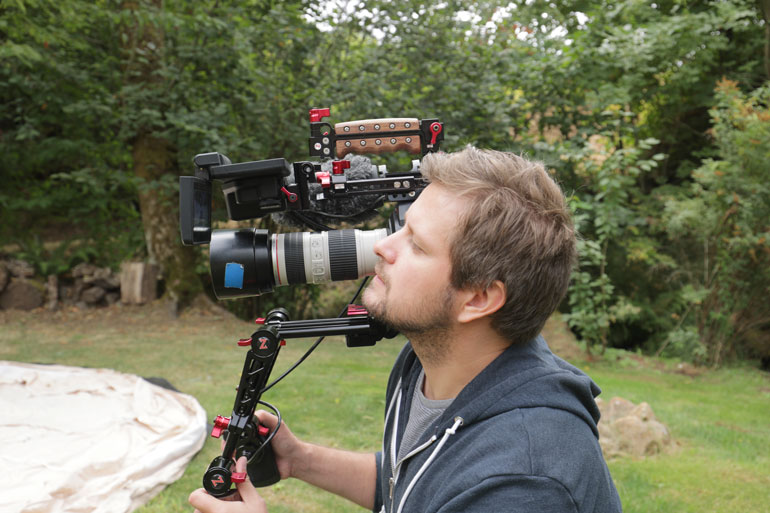
Rigging the Zacuto Recoil Pro without an EVF
As solo shooters or small crews, we’re also accustomed to producing while we’re operating a camera. That means directing the subjects while monitoring our audio, constantly adjusting focus, trying to nail exposure, framing while moving, thinking about the next shot/scene, and trying not to trip and fall with all of our equipment.
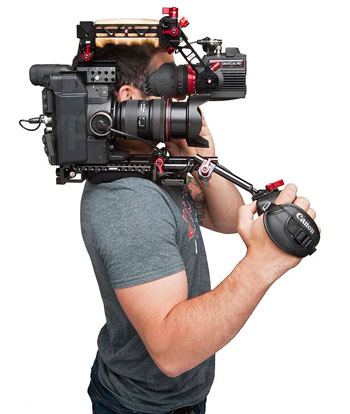
Having to do all that at the same time, spinning all those plates in your head, while carrying on a normal conversation with your subjects, clients, and crew members can be exhausting.
Now if we have to add a camera sitting on our shoulder inches away from us, with one of our eyes inside an EVF near full time, it just seems a little overwhelming.
It’s one thing if you’re operating a camera while someone else is doing all the direction and production, but that’s not the case for a lot of the shoots out there. Especially shoots where you’re running and gunning - i.e. situations where a shoulder rig would be especially helpful.
And so, as much as we want to use something like the Zacuto Gratical Eye, it’s a big transition for those of us who are not shoulder rig shooters already. Can’t we use an external monitor or our camera’s default display unit, until we're ready to move into an EVF?
The C300 comes with a really good display as it is, but even at it’s farthest position, it sits way too close to your eyes. Thankfully Zacuto makes a C300 display accessory that achieves this exact task - it moves the clamshell unit far enough away that you can use it on a shoulder rig like the Recoil Pro.
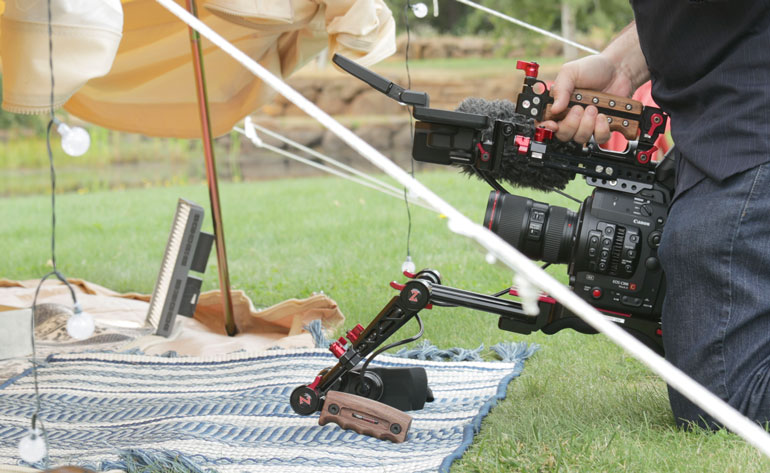
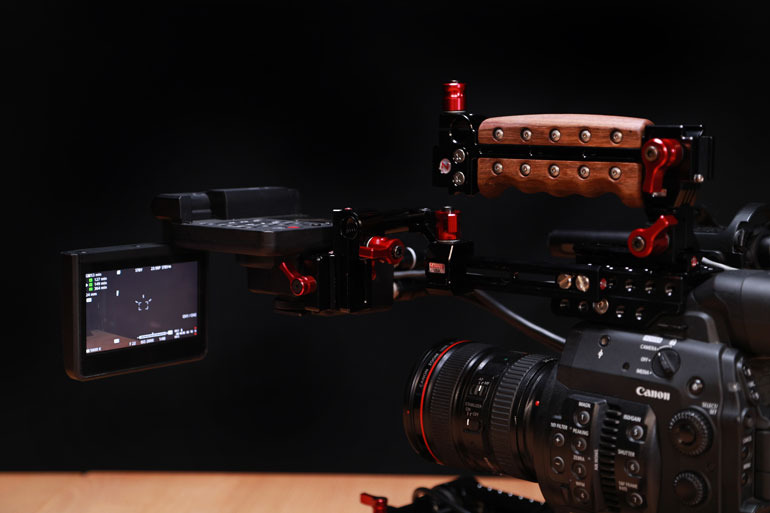
The Zacuto Mounting Kit for C300-C500 is actually made for a Z-finder, but it works perfectly without a hood or loupe. One end connects to Zacuto’s top plate, and the other end has a shoe bracket for the C300 monitor unit.
If you extend it to the farthest point possible, it makes the C300 monitor a good distance from your eyes, but still durable enough that it doesn’t feel wobbly or unstable.
It would be even better to use along with a battery plate behind the C300. That way, you can move the camera’s balancing point forward a few inches, giving you even more space in front of your eyes.
And of course, it solves the issue of having to replace the camera battery every couple hours. But for our purposes, we used the camera as it is, and it felt great.
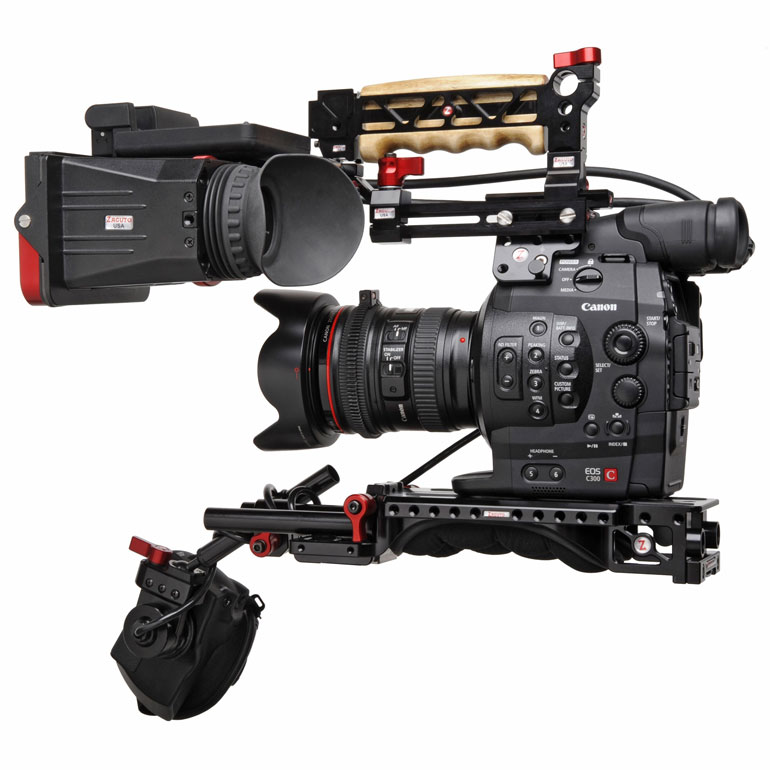
What would be even better is if you connected the monitor from the C200 - the Canon LM-V1 - and drop the clamshell entirely. We have an article about using the Canon C300 mkII with the C200 monitor.
Being able to reach up and touch the screen to set the autofocus is a really nice bonus feature. For audio, you could use a shotgun microphone with a built in battery, like the Rode NTG4 (this kit even comes with the shockmount we use), or add a Canon’s MA-400 XLR unit to connect your current shotgun mic.
Zacuto does make a Z-finder for the Canon C200, which places the monitor at a perfect distance for using both with or without the Z-finder loupe. That gives you options of how you want to shoot in a particular situation.
Preparation, Portability, and travel
Having never used the Recoil Pro before, we were a bit worried about the learning curve going into rigging the camera. But it honestly took no concerted effort to figure it out. Zacuto includes handouts that guide you through the basic setup, as well as customization options.
At one point, we tried using a Manfrotto 394 quick release plate to connect to the Recoil Pro’s VCT baseplate. That way, we could take the camera off quickly and use it on a tripod, monopod, slider or gimbal, all of which would have the Manfrotto base plate on it already. But the added weight of the Recoil camera top plate and handle - along with the display mounting kit, makes the C300 a little too wobbly on the little 394 plate.
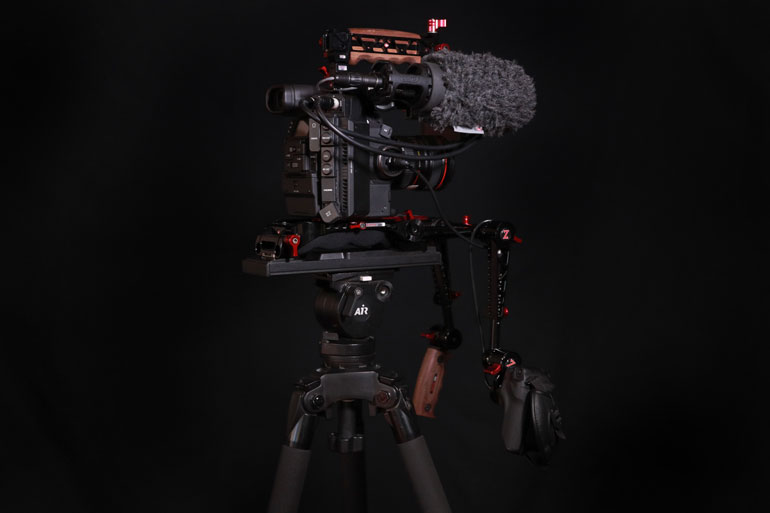
Luckily, the Recoil Pro has a built in VCT connection under the shoulder pad. So by adding an additional VCT tripod plate to the top of our Miller Air tripod, we can go from a shoulder setup to a tripod position very quickly. In our demo shoot, we did that a few times when we transitioned from B-roll to interviews.

And if you wanted to, you could add the VCT plate to the top of your monopod and slider too, enabling your whole setup to be quickly utilized in other shooting scenarios. The fact that you can press the trigger buttons and transform a shoulder rig setup into a folded, compact camera means that you no longer have to worry about how a shoulder rig and its rods and handles might get in the way.

Finally, one of the ways that the Trigger Grips really hit home for us is its ability to be packed up quickly in a bag, or be placed on a surface, without the usual frustrations of having to break down a shoulder rig. Folded up, our C300 mkII rig fit comfortably inside a Sachtler Dr. Bag 3.
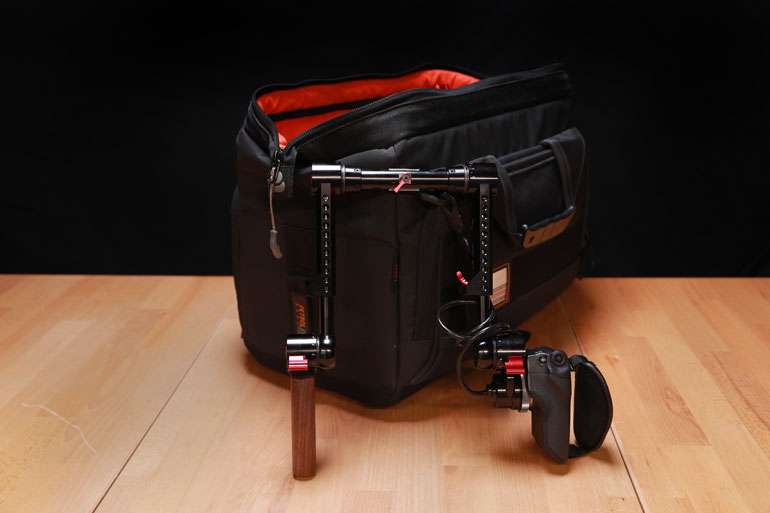
If your bag space is a little tight, you can quickly remove the dual trigger system and pack it next to your camera. And as soon as you want to shoot again, you just attach the trigger base to the 15mm rods and you’re ready to go with your handles positioned exactly where you want them already. This feature alone makes the Dual Trigger Grips an attractive addition to shooters who already have a shoulder rig system they use.
Zacuto Recoil Pro and Trigger Grips In the field
In our day of production with Jem Schofield, we went to an Oregon vineyard to shoot a piece about glamping (i.e. comfortable camping). We had only a few hours to gather all the B-roll and interview material for a short, promotional video. Having never been to the location before, or having met the clients or subjects, we had to ensure we could be nimble while capturing high end footage.

Not a bad location to test out the Recoil Pro
Jem took the lead in directing and operating the camera, while we added a few bonus shots with our Canon 1DX mkII on a DJI Ronin-S. It was a cloudy day that didn’t really call for wide shots, so we used a 70-200mm for the majority of the shots. That enabled us to focus on highlighting the models and action in a way that didn’t depend on the sun coming out. But it also meant we had to constantly shift and adjust framing.
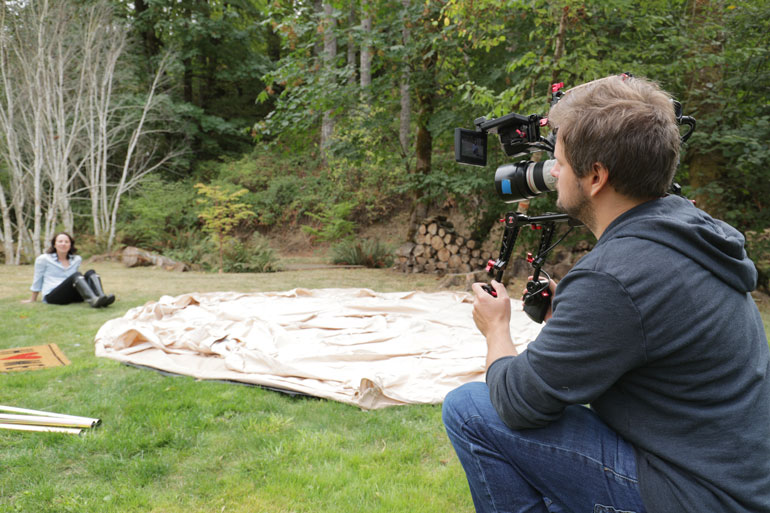
Being able to transition from a shoulder perspective to a low angle shot on the ground was essential in our short timeframe. We also had to shoot inside tents, which is a challenge no matter what you’re shooting with. In our case, we could swap lenses quickly to a Canon 16-35 f/4, without having to reconfigure the Recoil at all.
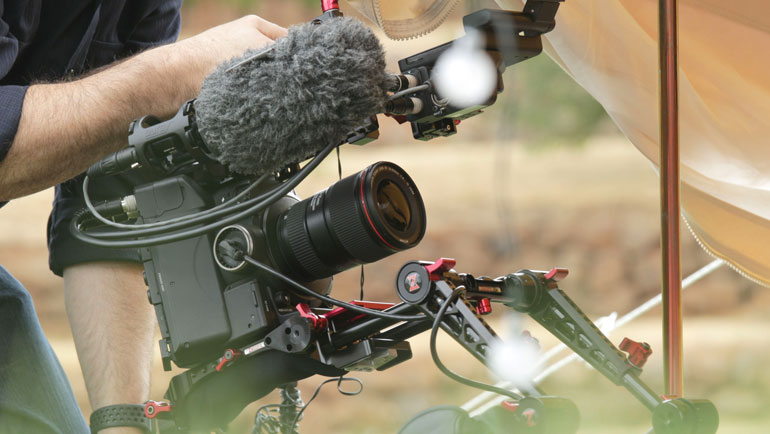
Even more, there were several times where we would swap operators, so one person could shoot a scene while the other was prepping the next shot. Having the dual trigger grips meant we could quickly adjust the placement of the camera grip and wooden handle to our personal preferance, quickly and without interrupting the production flow.
And finally, when it came to interviews, we could easily take the rig off our shoulder and transition into a tripod setup, without changing anything to our rig. Several of us could look at the screen to suggest framing, without us having to add another external monitor the setup. That was great, and the clients and subjects didn't have to wait for us to change gears.
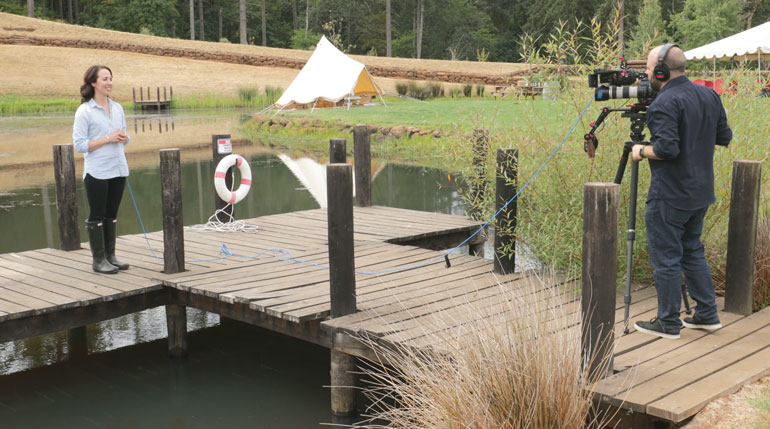
But most importantly, we could shoot a promotional piece, with all of the required direction and retakes, while still remaining on our feet and being able to move quickly. And neither the subjects nor the client ever mentioned our rig - it’s a huge win when no one feels threatened or intimidated by a rig on a shoot with non-professional subjects and inexperienced clients.

One of our video's subjects trying out the rig
The Recoil Pro and Trigger Grips do not give off the feeling of a huge, ultra complex camera rig. In fact, everyone actually enjoyed taking turns holding the rig, when we talked about what we were reviewing that day.
Conclusion
For those of us who prefer to shoot with a barebones camera, either handheld, or on a tripod or monopod, switching to a shoulder rig setup can feel a little intimidating. Not only does the rig become bigger and heavier, but you also have to rethink how you travel, how you shoot high and low angles, and even how you set the camera down.
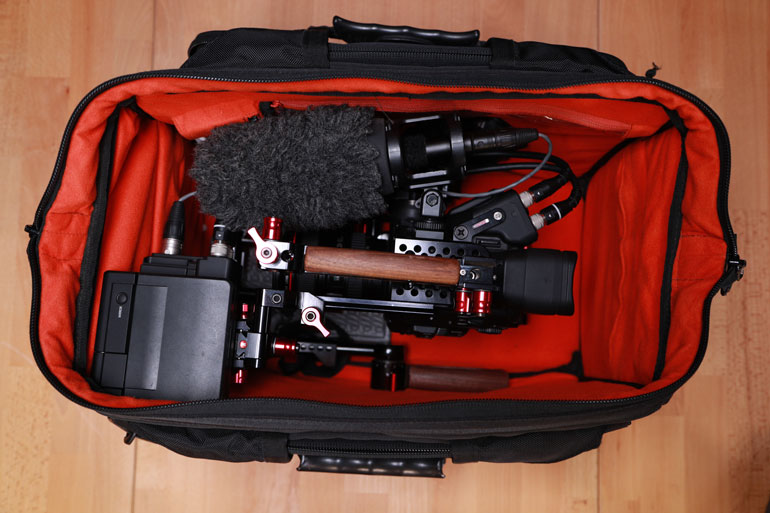
Being able to pack an assembled shoulder rig into a carry-on bag is amazing
That’s in addition to having to add an EVF or a monitor loupe to your workflow, which not only adds to the expense and complexity of the rig (i.e. more things that can go wrong), but also changes the way you interact with the world around you.
But the Zacuto Recoil Pro and Dual Trigger Grips for the C300 mkII makes the transition to shoulder rig shooting effortless. The addition of their mounting kit for the C300/C500 clamshell displays, or a custom solution that you could attach to the top of Zacuto’s rig, means you don’t have to think about an EVF solution…until you’re ready to try one out.
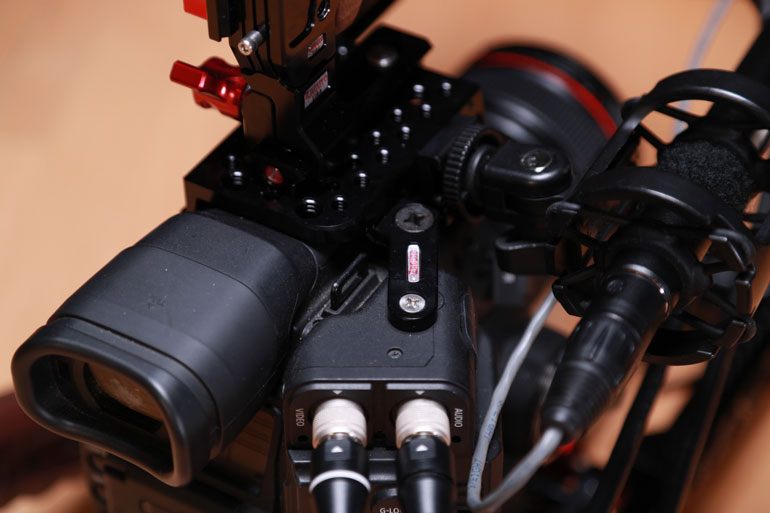
It's the little details that make Zacuto stand out, like multiple safety screws
We have lots of filmmaker friends who have been using their Zacuto rigs on many shoots over the years, and they’re still holding up. When you’re putting all this pressure on the many little knobs and screws that hold a rig together, there’s a lot of places where something could go wrong and damage your expensive camera. You don’t want to put that kind of stress on a cheaply made piece of gear.
Zacuto designs and manufactures all of their products in the USA, and they even have a lifetime guarantee for anything you buy from them. That kind of quality assurance means that you can depend on your purchase for many, many years to come.
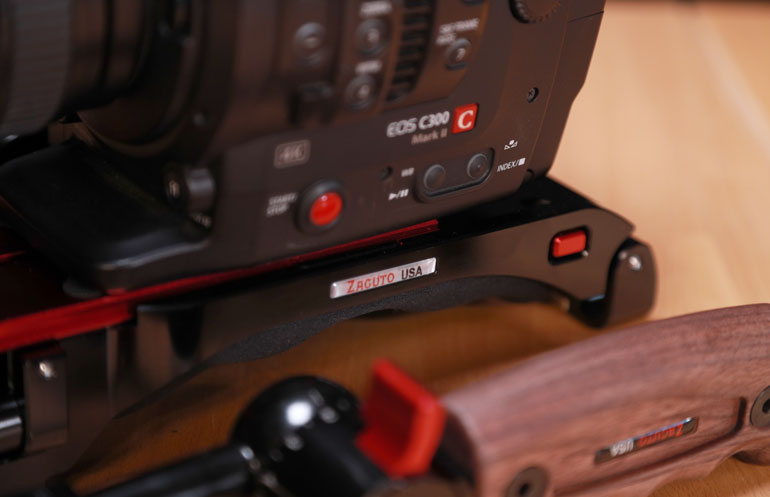
We were surprised to find that we really love shoulder rig shooting, after years of avoiding it for many of the reasons we’ve written about, thanks to this new combo from Zacuto. The new Recoil Pro and Trigger Grips can easily turn a handheld or tripod shooter into a shoulder rig convert. It did for us - and now we’ve gotta figure out what we can sell so we can buy one ourselves.
Zacuto Recoil Pro with Trigger Grips - Zacuto Official Store / B&H Photo Video
